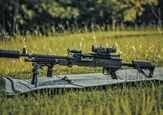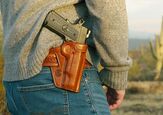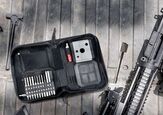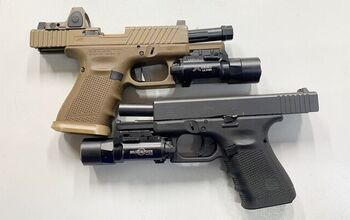Concealed Carry Corner: Speed Versus Accuracy
Welcome back to another edition of Concealed Carry Corner. Last week, we talked about red dots on carry guns and why they are a benefit to certain shooters. If you happened to miss that article, be sure to click the link here to check it out. This week, I want to talk about a common problem I see a ton of shooters both new and experienced fight to have the correct balance of speed versus accuracy. Some will go too fast and miss their shots while others will have perfect hits but will take way too long to make their shots. So what's the solution? Let's take a closer look at the constant battle between speed and accuracy.
Speed is Certainly Important
For younger shooters, many will focus on speed. They want to go as fast as they can in order to stop the threat and get rounds on target. They all naturally start to speed up their shots and as a result, accuracy drastically decreases in a relatively short amount of time. Although speed is an incredibly important factor, I do not believe it's the most important aspect of carrying. Last year I went down to Miami for a training course and the instructor was adamant that you need to go as fast as possible and with enough practice, your accuracy will catch up. This is certainly not the correct way of thinking when looking at self-defense shooting and how to train for a dangerous situation.
Certain elements need to incorporate speed. Aspects like your draw stroke and how fast you can present your firearm on target are where the speed needs to be applied first. The faster you can get your gun on target and be ready to make the first shot, the more likely you are to survive an encounter. Where you shouldn’t speed up is on that first shot in a self-defense situation. There are a few reasons why you shouldn't rush when it comes to firing but we will dive into that a bit later. The main takeaway point when it comes to speed is the fact you need to be as fast as possible during certain aspects of drawing a firearm while slowing down when it comes to important parts like actually firing the handgun.
Accuracy Matters
The one saying I always remember is from Ric Sutton who is one of the former head trainers at BlackWater. Ric always says “Fast is fine but accuracy is final.” Of course, you history buffs are screaming at your computer at the fact that that's an original quote from Wyatt Earp which you’d be correct. Whether it's back in the 1800s or in modern times, the concept of being fast but accurate has been consistent since people started carrying handguns. Accuracy in your self-defense shooting can be the difference between stopping a threat and missing your target only to injure or kill an innocent bystander.
It's important to train enough to consistently hit the A zone of a cardboard IPSC target. The most common term for this would be throttle control where you can fire faster if the target is larger and slow down if you need tighter shots on a smaller target. Having a confidence level when it comes to handgun accuracy is also a key factor. You have to have enough of a baseline and experience with your handgun to confidently shoot an acceptable group. If you had to focus on either speed or accuracy, I would always prioritize accuracy with speed coming as you become more confident in your abilities.
How To Navigate And Find A Balance
While speed and accuracy are equally important you have to have a balance of both aspects to be successful. Having a fast draw stroke and being able to quickly present your firearm is key while firing slow enough to make accurate consistent shots. Practice is the biggest factor in making sure you can quickly lay accurate shots onto a threat. Various live fire exercises like the Dot Torture Drill and F.A.S.T drill are both fantastic options to test your speed and accuracy.
Using a timer can give you a tangible tracking tool that allows you to document your progress and see not only your hits but also your times to collect all the info into a journal. Some of you don't like to hear it, but shooting twice a year with your carry gun just isn't going to cut it. Taking your carry gun every two weeks to a month to the range allows you to be consistently training so your skills don't degrade over time. Shooting is a perishable skill and the only way to stop those skill sets from deteriorating is to practice either dry fire or live fire exercises like we have talked about over the last couple of months.
Overall Thoughts
People always say either speed is the most crucial skill to have or accuracy is key with an emphasis on making tight groups when they train. The truth always falls somewhere in between and this is certainly the case. There is definitely a balance in finding the amount of speed you can go to be as fast as possible while maintaining your acceptable accuracy where you can consistently make hits. With just a bit of practice, you can find the sweet spot where you can accurately make hits at an appropriate speed. Practicing at the range will allow you to progress your draw speed and presenting your handgun while having proper throttle control and making your hits.
Let me know what you guys think about what's most important down in the comments below. If you have questions about carrying concealed or firearms in general, feel free to shoot me a message on Instagram @fridgeoperator. Stay safe out there and we will see you next week for another edition of Concealed Carry Corner.
TFB’s Concealed Carry Corner is brought to you by GLOCK
I'm an avid shooter and love educating whether it's at my job or in the shooting community. I'm an average joe that really loves talking with other people about firearms and other passions.I'm active on Instagram on @fridgeoperator.
More by Matt E
























![[NRAAM 2024] The Glock G17L is Back and it's Optics Ready](https://cdn-fastly.thefirearmblog.com/media/2024/06/04/064426/nraam-2024-the-glock-g17l-is-back-and-it-s-optics-ready.jpg?size=350x220)





Comments
Join the conversation
It is a well known phenomenon that you usually shoot more rounds than you realize in a DGU. The faster you shoot the more extraneous rounds you will fire. The more rounds you fire the more scrutiny you will get from the DA even if he is pro 2A. Speed has diminishing returns. You only have to be fast enough but you always need to he accurate.
Since I started carrying I go at least once a month to the range. I've been amazed how good my shooting gotten. Coupled with dry fire practice often and carrying the same type of gun year round, Glock 19 in the colder months, 43x in the warm ones...I feel more comfortable in my shooting skills than ever before.